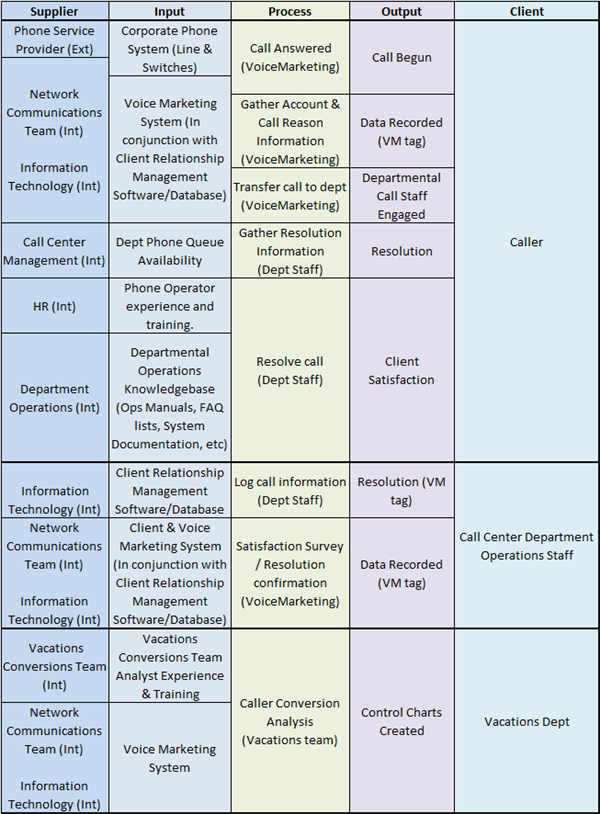Welcome back to our case study. Previously we’ve:
- Kicked off the project. (And here.)
- Secured sponsor support.
- Started creating the project charter. (Problem statement, goals, business case.)
If you’re not caught up, go ahead and take a few minutes to read through. Don’t worry, we’ll be right here when you return.
This time we will focus on defining our process in preparation for refining our stakeholder list. These activities will inform scope and help us outline our schedules and deliverables, completing the project charter step.
Defining our Process
Previously, Nicole Greyling suggested that we make a high-level process map and understand the voice of the customer (VOC). Right she is! Let’s get to work.
High Level Process Map
After speaking with our main contacts we are able to generate a basic overview. Looking at the overall process, we come up with something like this:
- Call comes in to AAF.Welcome message prompts callers to authenticate.
- If callers can authenticate by entering their member IDs, they pass through to the menu selection step.
- If callers cannot authenticate they are sent to a Service Associate who will help authenticate them.
- Once authenticated they callers are sent to the menu selection step.
- If callers do not have a membership, they are routed to New Member services for general inquiries.
- Callers select from a menu (general inquiries, find a local service center, membership questions, roadside assistance/emergencies, insurance, travel planning.)
- Call is routed to the appropriate area.
- The Voice Marketing program is engaged while callers wait for their turn in the queue.Service Associate handles call.
- Voice Marketing is engaged each time a user is placed on hold.
- Call ends.
- Caller ends call
- Or
- Service associate ends call.
- System directs callers to optional satisfaction survey.
- Caller completes survey
- System ends calls.
- Or
- Caller ends call
- Caller completes survey
- System directs callers to optional satisfaction survey.
- Caller ends call
After a assimilating this information we are left with this basic, High Level Process Map

The next step could be to start making a process map to show the different swimlanes and path possibilities and responsibilities.
For now, let’s jump into making a SIPOC. Be forewarned – in practice I find that very few High Level Process Maps survive intact after making a SIPOC. That’s OK. Six Sigma documents are rarely once-and-done endeavors. These are living artifacts. Expect to change them and edit them as you learn more information.
SIPOC
A SIPOC is a useful tool to ensure everyone has the same understanding of the process. Also, I find that by reviewing it with multiple parties you inevitably uncover more details about the true scope, interactions, and stakeholders involved.
I’ve found that making a SIPOC and socializing it with others usually results in a completely different understanding of the problem at hand and the scope of the project.
Let’s assume we’ve dove in to the High Level Process Map to investigate Inputs and Outputs to each of the main process steps. That in turn will lead us to other ‘invisible’ steps, which will in turn lead us to more inputs and outputs.
To my mind, the most valuable work of the whole DMAIC project might be making a single visual for all parties to see how interdependent they are on each other. Once you get process owners to understand that the q their outputs are another teams’ essential inputs and their first-pass quality directly impacts the whole, you’re half way there to leaning out a process.
While there are multiple obvious improvements that are emerging, we are evaluating the process for strategic reasons. Let’s look through the SIPOC.

Next Steps
Once we have the high-level process map and SIPOC complete we can leverage that information to create our Stakeholder’s list.
And although it could very well be used in the Measure phase, I like to illustrate RTY – Rolled Throughput Yield on the High Level Process Diagram for use in the Define Phase Tollgate Review.
From there we will focus on completing the Define Phase by:
- Obtaining the Voice of the Customer
- Completing formal project selection.
Active Participation
- What do you think about the High Level Process Map? Does it illustrate any details we should consider investigating further in the Measure Phase?
- Is the SIPOC complete? How would you update the SIPOC?
- How can we use the SIPOC to inform our Stakeholder list?

